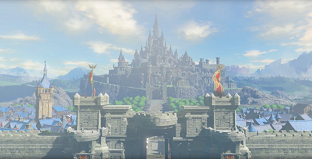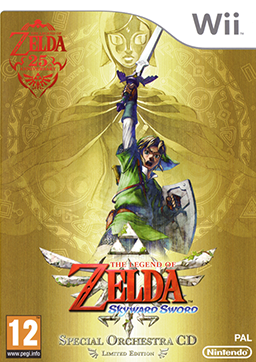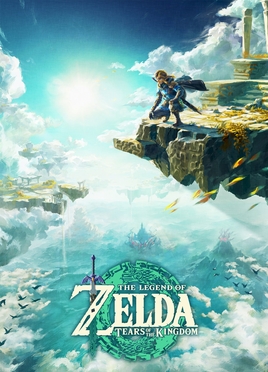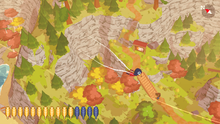
The Legend of Zelda is an action-adventure game franchise created by the Japanese game designers Shigeru Miyamoto and Takashi Tezuka. It is primarily developed and published by Nintendo, although some portable installments and re-releases have been outsourced to Flagship, Vanpool, and Grezzo. The gameplay incorporates action-adventure and elements of action RPG games.

The Legend of Zelda is a video game franchise created by Japanese video game designers Shigeru Miyamoto and Takashi Tezuka and mainly developed and published by Nintendo. The universe of the Legend of Zelda series consists of various lands, the most predominant being Hyrule. The franchise is set within a fantasy world reminiscent of medieval Europe which consists of several recurring locations, races and creatures. The most prominent race in the series are the Hylians, a humanoid race with elfin features identifiable by their long, pointed ears. The series' lore contains a creation myth, several fictional alphabets, the most prominent being Hylian, and a fictional universal currency, the rupee. Most games in The Legend of Zelda series follow a similar storyline, which involves the protagonist Link battling monsters to save Princess Zelda and defeat a villain, which is often the series' main antagonist, Ganon. Nintendo developed the series' lore into a timeline that spans thousands of years across its history.

Shigeru Miyamoto is a Japanese video game designer, producer and game director at Nintendo, where he serves as one of its representative directors as an executive since 2002. Widely regarded as one of the most accomplished and influential designers in video games, he is the creator of some of the most acclaimed and best-selling game franchises of all time, including Mario,The Legend of Zelda, Donkey Kong, Star Fox and Pikmin. More than 1 billion copies of games featuring franchises created by Miyamoto have been sold.

The Legend of Zelda: The Wind Waker is an action-adventure game developed and published by Nintendo for the GameCube. An installment in The Legend of Zelda series, it was released in Japan on December 13, 2002, in North America on March 24, 2003, and in Europe on May 2, 2003.

A virtual pet is a type of artificial human companion. They are usually kept for companionship or enjoyment, as people may choose to keep a digital pet instead of a real one.

The Tamagotchi is a handheld digital pet that was created in Japan by Akihiro Yokoi of WiZ and Aki Maita of Bandai. It was released by Bandai on November 23, 1996 in Japan and in the United States on May 1, 1997, quickly becoming one of the biggest toy fads of the late 1990s and the early 2000s. As of June 2023, over 91 million units have been sold worldwide. Most Tamagotchi are housed in a small egg-shaped handheld video game with an interface consisting of three buttons, with the Tamagotchi Pix adding a shutter on the top to activate the camera.

Princess Zelda is a character in Nintendo's The Legend of Zelda video game series. She was created by Shigeru Miyamoto for the original 1986 game The Legend of Zelda. As one of the central characters in the series, she has appeared in the majority of the games in various incarnations. Zelda is the elf-like Hylian princess of the kingdom of Hyrule, an associate of the series protagonist Link, and bearer of the Triforce of Wisdom.

Link is a character and the protagonist of Nintendo's video game franchise The Legend of Zelda. He was created by Japanese video game designer Shigeru Miyamoto. Link was introduced as the hero of the original The Legend of Zelda video game in 1986 and has appeared in a total of 20 entries in the series, as well as a number of spin-offs. Common elements in the series include Link travelling through Hyrule whilst exploring dungeons, battling creatures, and solving puzzles until he eventually defeats the series' primary antagonist, Ganon, and saves Princess Zelda.

Ganon is a character and the main antagonist of Nintendo's The Legend of Zelda video game series and franchise, as well as the final boss in many Zelda titles. In his humanoid Gerudo form, he is known as Ganondorf. A massive and malevolent pig-like creature, Ganon first appeared in the original The Legend of Zelda game in 1986, while his alter ego, Ganondorf, was introduced in Ocarina of Time. He has since appeared in the majority of the games in the series in various forms. He is the archenemy of the protagonist Link and Princess Zelda of Hyrule and originally the leader of the Gerudo, a race of humanoid desert nomads before becoming the ruler of his demon army.

Nintendogs is a real-time pet simulation video game developed and published by Nintendo for the Nintendo DS handheld video game console. It was released in Japan, and was later released in: North America, Australia, New Zealand, Europe and other regions. It was originally released in three different versions: Dachshund & Friends, Lab & Friends and Chihuahua & Friends. It has been re-released twice, first as a bundled release with a special edition Nintendo DS with a new version called Nintendogs: Best Friends and later as Nintendogs: Dalmatian & Friends.

Life simulation games form a subgenre of simulation video games in which the player lives or controls one or more virtual characters. Such a game can revolve around "individuals and relationships, or it could be a simulation of an ecosystem". Other terms include artificial life game and simulated life game (SLG).

The Legend of Zelda: Skyward Sword is a 2011 action-adventure game developed and published by Nintendo for the Wii. A high-definition remaster of the game, The Legend of Zelda: Skyward Sword HD, was co-developed by Tantalus Media and released for the Nintendo Switch in July 2021.

In video games, an open world is a virtual world in which the player can approach objectives freely, as opposed to a world with more linear and structured gameplay. Notable games in this category include The Legend of Zelda (1986), Grand Theft Auto III (2001) and Minecraft (2011).

Navi is a fictional fairy who acts as series protagonist Link's navigator throughout the 1998 Nintendo 64 video game The Legend of Zelda: Ocarina of Time. She was voiced by Kaori Mizuhashi. Navi performs a variety of functions within the game, including being a companion and guide to Link, providing the player with advice and being a focal point for the game's Z-lock targeting combat system. Other characters in The Legend of Zelda series have served in similar roles, including Tatl, Midna, and Fi. When designing the reticle for the game, designer Yoshiaki Koizumi made a ball of light with wings, naming it "Fairy Navigation System" before naming it Navi. She has been widely criticised by players and critics for her repetitive interruptions in gameplay, particularly with the prompt "Hey! Listen!", though some have argued that she was a valuable companion in the game.

The Legend of Zelda: Breath of the Wild is a 2017 action-adventure game developed and published by Nintendo for the Nintendo Switch and Wii U. Set at the end of the Zelda timeline, the player controls an amnesiac Link as he sets out to save Princess Zelda and prevent Calamity Ganon from destroying the world. Players explore the open world of Hyrule while they collect items and complete objectives such as puzzles or side quests. Breath of the Wild's world is unstructured and encourages exploration and experimentation; the story can be completed in a nonlinear fashion.
Cabbage was a canceled breeding simulator video game that was planned for release in the late 1990s on the 64DD, an expansion peripheral for the Nintendo 64 console. The prototype was developed by a team of Nintendo's "biggest talents", led by Shigesato Itoi, Tsunekazu Ishihara, Shigeru Miyamoto, and eventually Satoru Iwata. Miyamoto spoke eagerly about the innovative development of Cabbage across the years until early 2000. Years later, he reflected that it had drifted silently into cancellation but that it deeply influenced other Nintendo games such as Animal Crossing and Nintendogs.

The Legend of Zelda: Tears of the Kingdom is a 2023 action-adventure game developed and published by Nintendo for the Nintendo Switch. The player controls Link as he searches for Princess Zelda and fights to prevent Ganondorf from destroying Hyrule. Tears of the Kingdom retains the open-world gameplay and setting of its predecessor, Breath of the Wild (2017), and features new environs including the sky, an area composed of floating islands, and an expansive cavern beneath Hyrule known as the Depths. The player has access to various devices that aid combat or exploration, and which can be used to construct vehicles.

Prince Sidon is a fictional character in Nintendo's The Legend of Zelda series. He first appeared as a major character in The Legend of Zelda: Breath of the Wild. He reappears as a playable character in the hack-and-slash video game Hyrule Warriors: Age of Calamity. Sidon is the prince and eventual king of the amphibious Zora and younger brother of Mipha, one of the four Champions who helped Princess Zelda and Link fight Calamity Ganon. In Breath of the Wild, Sidon helps Link to reach Divine Beast Vah Ruta so he can defeat Waterblight Ganon and free it from Ganon's control. Since his debut, Sidon has received overwhelmingly positive reception from both fans and critics. He was designed by Yuko Miyakawa, who gave him grey skin and a hammerhead shark motif, though his skin was changed both due to blending issues and to match his skin color with Mipha's. Due to his personality, he has achieved a large fan following and has also been the subject of fan art and Internet memes on social media. He and Link have also been interpreted as a couple, with their ship name being "Sidlink," such that him being in a relationship with a female Zora named Yona in The Legend of Zelda: Tears of the Kingdom receiving a negative reaction from some shippers.

















